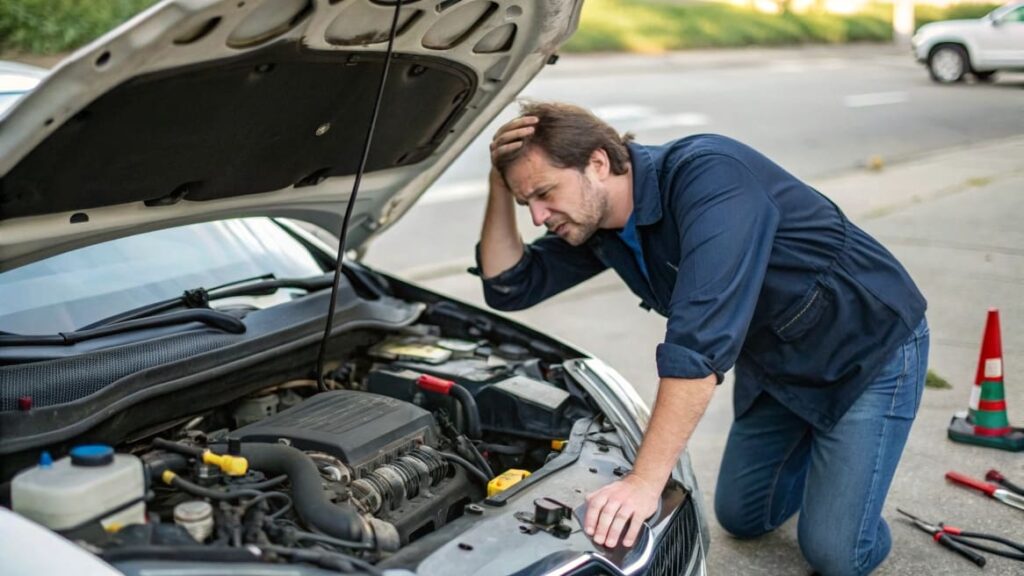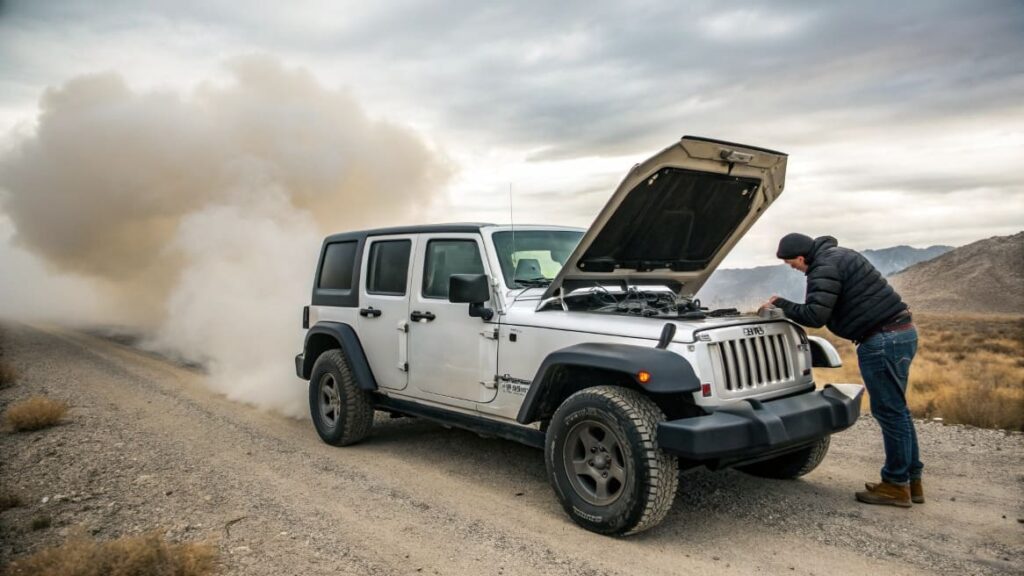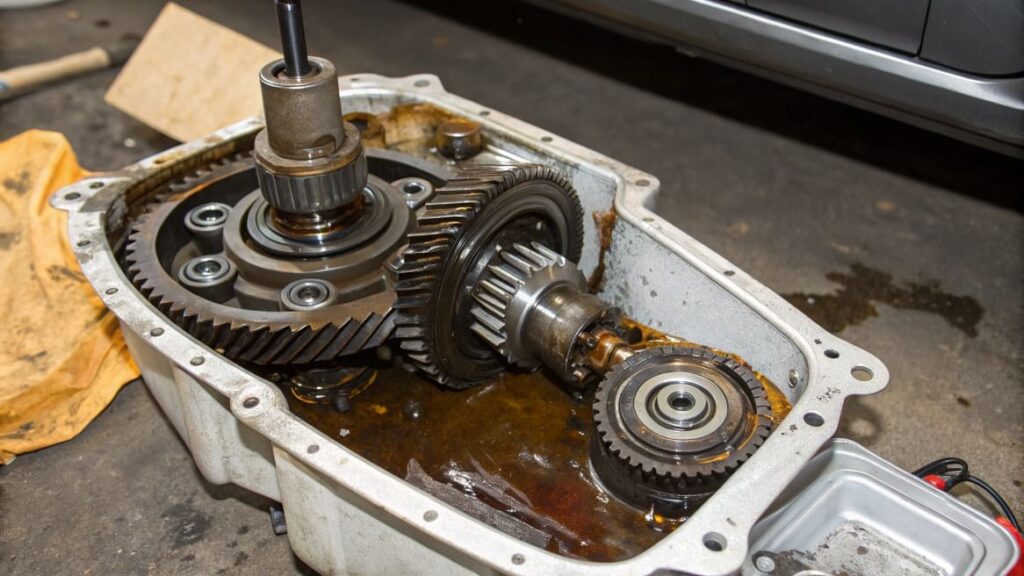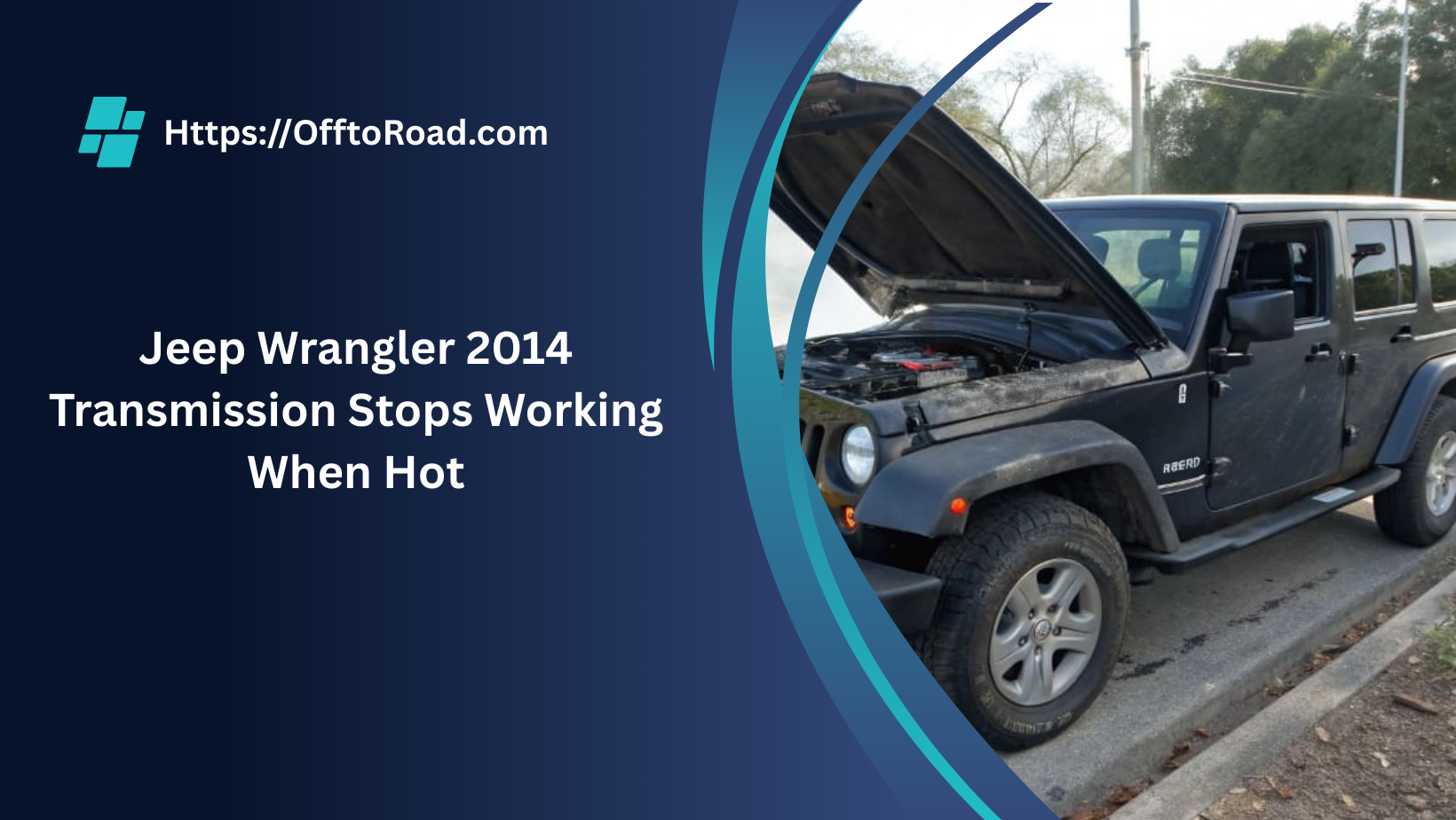If your 2014 Jeep Wrangler’s transmission stops working when hot, it could be due to overheating or low fluid. Regular maintenance and checking fluid levels can help prevent this issue.
If you’ve noticed that your 2014 Jeep Wrangler’s transmission stops working when it gets hot, don’t worry—you’re not alone. There are a few common reasons for this, from issues with the transmission fluid to problems with internal components. Let’s dive into what could be causing the issue and how you can go about fixing it.
What exactly could be going wrong?
When your transmission stops working as it heats up, it usually points to a few possible trouble spots. Let’s break them down in a way that’s easy to follow.

Transmission Fluid Issues — the most common culprit:
First things first — your Wrangler’s transmission relies heavily on fluid to stay cool and work smoothly. If the fluid is low, dirty, or wrong, problems can show up fast.
- Low fluid: When you don’t have enough fluid, things heat up too quickly, and your transmission loses lubrication. That alone can cause it to stop working.
- Wrong fluid type: If you’ve accidentally used the wrong type of transmission fluid, that can mess with how your transmission shifts and stays cool. It’s always best to double-check you’re using the right fluid for your 2014 Wrangler (consult your owner’s manual or mechanic if you’re unsure).
Internal Components — parts inside wearing out:
Now, moving on — if your fluid checks out, we need to consider the parts inside the transmission.
- Valve body issues: The valve body helps control how and when your Jeep shifts gears. If it’s faulty, your Wrangler might not shift correctly — or at all.
- Clutch plates & piston seals: Over time, wear and tear on these internal pieces can also lead to slipping or full transmission failure. Basically, if the clutch plates or seals aren’t holding pressure, your Jeep won’t move properly.
Electrical Components — yes, it’s not just mechanical!:
Okay, here’s something many folks don’t think about. Your transmission relies on electronics too — and when those fail, it can mimic mechanical problems.
- Faulty relays: There’s a relay that controls the transmission control unit (TCU). If that relay fails, power might not reach the TCU, which can cause your Jeep’s transmission to basically “go dark” and stop functioning.
- Wiring or sensors: Sometimes, worn-out wires or faulty sensors can confuse the system and cause the same shutdown effect.
Also Read: https://offtoroad.com/why-are-there-so-many-jeeps-for-sale/
Here’s what I’d recommend doing next — step by step:
Don’t worry, we’re getting close to figuring this out! If I were in your shoes, here’s the checklist I’d follow to troubleshoot the problem.
Check transmission fluid levels:
Pop the hood, check the dipstick, and make sure the fluid level is within the safe zone. Top it off if needed.
Inspect for leaks:
Take a quick look under the Jeep and around the transmission pan. Any wet spots, drips, or puddles? That’s a sign of a leak that needs fixing.
Run a diagnostic scan:
Most auto parts stores (like AutoZone or O’Reilly’s) will scan your Jeep for free. This scan checks for error codes that can give clues about solenoids, relays, or sensors that might be acting up.
Get a professional inspection:
If nothing obvious jumps out or if the codes are confusing, it’s time to visit a trusted mechanic. They’ll have the tools and know-how to dig deeper and pinpoint the exact issue.
A couple of quick but important notes:
Before you jump back on the road, here are two things I really want you to keep in mind:
Don’t ignore the problem — A failing transmission can quickly get worse and lead to much pricier repairs if you keep driving it. Trust me, addressing it early saves a lot of headaches (and money).
Safety first — If your transmission isn’t shifting properly or the Jeep is overheating, don’t risk driving it. Getting stranded or causing further damage isn’t worth it — have it towed if you’re unsure.
Final thoughts — from one Jeep lover to another:
I know transmission problems sound intimidating, but if you catch it early and take it step by step, you’ll be back on the road (or trail) sooner than you think. Your 2014 Wrangler has a lot of life left — it just needs a little care to get through this hiccup.
2014 JK auto transmission causing overheating?

So let’s say you’re cruising around in your 2014 Jeep Wrangler JK, and suddenly you notice the transmission is running hotter than it should. Honestly, that can make anyone’s heart sink. But here’s the good news — we can walk through what’s going on together in a way that makes sense and doesn’t feel overwhelming.
Can the transmission really cause overheating?
Absolutely, yes. Even though a lot of us don’t think about it, your transmission and your engine work closely together, especially when it comes to keeping things cool. So if your transmission is overheating, it can easily make the whole Jeep run hotter than normal. Now, let’s break down why that might be happening and how you can fix it without losing sleep.
Transmission fluid problems:
In my experience, this is the first place to check because it’s super common and pretty easy to spot.
- Low fluid: When you don’t have enough fluid, the transmission can’t stay cool or lubricated properly. Especially if you’ve been driving hard, towing, or climbing hills, that fluid can get hot fast.
- Old or burnt fluid: Over time, transmission fluid breaks down. If it looks dark, dirty, or smells burnt, it’s lost its ability to cool things down efficiently.
Here’s what you can do right now:
Pop the hood and check your fluid level and color. If it’s low or looking nasty, top it up or go ahead and get a fluid change. Trust me, it makes a difference.
Don’t forget about the Transmission cooler — it might be struggling:
Now, if your fluid looks fine, the next thing I’d check is the transmission cooler. This little component acts like a mini radiator just for your transmission.
- If the cooler is clogged, cracked, or leaking, it can’t cool the fluid properly anymore.
- Plus, if you’re the type of driver (like me) who loves towing campers or off-roading on weekends, the stock cooler just might not be big enough for how you use your Jeep.
Also Read: https://offtoroad.com/2016-jeep-wrangler-engine-cover-is-burning-but-not/
What you can do next:
Take a look at the cooler and the lines connected to it. If you see leaks, blockages, or damage, it might be time to repair it or even upgrade to a bigger cooler — especially if you love heavy-duty driving.
Let’s talk about Heavy driving and towing — it wears things out faster:
Here’s something I learned the hard way — if you’re towing, off-roading, or driving long distances in hot weather, that can put extra pressure on your transmission.
- All that hard work causes more heat, and if your system isn’t perfectly maintained, it can’t keep up.
- The hotter things get, the higher the risk of slipping, poor shifting, or even a shutdown.
What you should consider:
Take breaks to let things cool on long trips or trails, and again — a transmission cooler upgrade can save you a lot of trouble down the road.
Don’t skip over the Radiator and cooling system:
Now here’s a little curveball most people don’t expect — your engine’s radiator also helps cool the transmission (since they share parts of the cooling circuit).
- If your radiator is clogged or low on coolant, that affects both the engine and the transmission.
- And yes — that can absolutely cause transmission overheating too.
What you can do:
Check your radiator fluid, and make sure it’s topped off and clean. If it’s been a while, a coolant flush could help both your engine and transmission stay cooler.
Quick, easy checklist:
If I were working on your Jeep in my driveway, here’s exactly what I’d check in order:
- Fluid level and condition.
- Cooler and cooler lines
- Radiator coolant level and condition
- Think about your driving habits (towing/off-roading?)
- If stuck, get a diagnostic scan or chat with a mechanic
What’s the bottom line?

At the end of the day, transmission overheating on your JK is super flexible — as long as you catch it early and take a few simple steps. Whether it’s fresh fluid, a cooler upgrade, or a quick radiator flush, you’ll probably be back on the road (or trail) faster than you think.
2015 Auto transmission issue?
If your 2015 Jeep Wrangler’s automatic transmission is giving you trouble, you’re definitely not alone. I’ve seen plenty of Jeep folks scratching their heads over similar issues. The good news is — once we take a closer look at what might be going on, things won’t feel so overwhelming. So, let’s walk through this step by step together.
What kind of problems are we talking about?
Before we jump into possible fixes, it helps to be clear about the symptoms you might be noticing. From what I’ve seen and heard, you could be dealing with things like hard or rough shifting (where your Jeep jerks into gears), gear slipping (RPMs spike but your speed doesn’t catch up), or delayed engagement (a little pause when you shift into Drive or Reverse). You might even hear some strange noises, like whining or clunking, or see a transmission overheating warning pop up on the dash.
If any of these sound familiar, don’t worry — you’re on the right track by digging into the issue now.
Let’s start with the basics — is your transmission fluid okay?
Now, in my experience, the first thing you should check is always the transmission fluid. I know it sounds simple, but trust me — it’s often the root of the problem. Low fluid or old, dirty fluid can cause all sorts of issues like slipping, rough shifts, and overheating.
Here’s what I’d do if I were standing in front of your Jeep right now: Pop the hood, check the fluid level, and look at the color. If it’s low, just top it up. If it looks dark or smells burnt, it’s definitely time for a fluid flush and replacement. Honestly, sometimes just fresh fluid can make the transmission feel like new again.
Also Read: https://offtoroad.com/jeep-wrangler-oil-type/
What if fluid isn’t the issue?
If the fluid looks good but things are still acting up, the next place I’d look is the Transmission Control Module (TCM). Think of this as the brain of your transmission — it tells the system when and how to shift. When it starts malfunctioning, you could get weird shifting patterns, gear slipping, or even find yourself stuck in one gear.
Here’s where a diagnostic scanner comes in handy. If there’s a fault, you’ll probably see a check engine light and get some error codes that point to the TCM. Sometimes a simple reset or reprogram does the trick — other times, the TCM might need to be swapped out.
Don’t forget the small parts — shift solenoids matter too:
Moving on, let’s chat about shift solenoids. These little guys control how transmission fluid flows to engage different gears. When one of them goes bad, you’ll feel rough or delayed shifts, or even experience slipping.
The good news? A diagnostic scan can usually pinpoint a bad solenoid pretty quickly. Replacing it isn’t too big of a job, and once it’s done, your Jeep should shift much smoother.
Valve body problems:
If none of that solves the problem, we have to consider valve body wear. Over time — especially if you’ve been off-roading or towing a lot — the valve body can wear down or get clogged. That can cause erratic shifting or slipping, and unfortunately, it’s not something you can eyeball easily.
In this case, I’d recommend getting a professional inspection. If they confirm it’s the valve body, you might be looking at a repair or replacement.
Torque converter troubles — less common, but possible:
While it doesn’t happen as often, the torque converter can also be a source of problems. If it’s starting to fail, you might notice shuddering, slipping, or weird noises — especially at highway speeds. And yep, it can even trigger overheating.
If all signs point here, you’ll likely need a torque converter replacement — but again, this isn’t as common as fluid or solenoid issues.
What causes a transmission to stop working when it gets hot?
When your transmission stops working after it gets hot, it can definitely be frustrating. But don’t worry, this issue is actually pretty common, and usually, it’s caused by a few key things. Let’s walk through what might be happening:

Low or Dirty Transmission Fluid:
First things first — fluid plays a huge role in how well your transmission works. When the fluid is low or it’s become old and dirty, it can’t lubricate and cool your transmission properly. This means, as your vehicle heats up, the fluid loses its effectiveness, causing things to start slipping, or even stop working altogether. So, checking your fluid level and condition is always a good starting point. If it’s low or looks dark and burnt, it might be time for a fluid change.
Transmission Overheating:
Another common cause is overheating. Transmissions rely on a cooling system to regulate their temperature. If your transmission cooler is clogged or the cooler lines are leaking, the fluid won’t cool down properly. As the transmission gets too hot, it can cause the internal parts to expand or seize up, making it struggle to work — or stop working completely. If your transmission is running hot, you’ll want to have the cooling system checked to make sure it’s doing its job.
Faulty Solenoids:
Moving on to solenoids — these are little components that help control the flow of transmission fluid in and out of the system. When your transmission gets hot, a faulty solenoid may stop working as it should, causing delayed shifting or even complete failure to engage gears. If the solenoids are the issue, you’ll likely need a mechanic to replace them, but luckily, this can be done without replacing the entire transmission.
Worn Valve Body:
Next up, we have the valve body, which controls the flow of fluid to different parts of the transmission. Over time, it can wear out, and when it does, it can fail to properly direct the fluid where it’s needed — especially when things heat up. If the valve body isn’t working right, you might notice rough shifting or the transmission just not working properly when it gets hot.
Also Read: https://offtoroad.com/are-jeep-wranglers-front-wheel-drive/
Internal Clutch Problems:
Clutches inside the transmission are responsible for shifting gears. If they’re worn out or damaged, they may not engage properly when the transmission heats up. This can cause slipping or prevent the transmission from shifting at all. This one can be a little trickier to fix and may require some internal work on the transmission, but it’s a pretty common issue.
Electrical Issues:
You may not always think of it, but electrical problems can also cause transmission issues when it gets hot. Many modern transmissions rely on sensors and control units to manage shifting. If there’s a fault in the electrical system, things may work fine when it’s cool, but heat can cause the electrical components to fail temporarily. If this is the case, a mechanic might need to run a diagnostic to pinpoint the exact issue.
Torque Converter Trouble:
Lastly, let’s talk about the torque converter. This is the part of the transmission that transfers power from the engine to the transmission. If it’s not working right, especially when it gets hot, the transmission won’t engage properly and can feel like it’s not responding. If your torque converter is on the fritz, you’ll likely need it replaced to get things back in working order.
What Can You Do About It?
If you’re noticing your transmission acting up when it’s hot, there are a few things you can try before panicking. Here’s a simple checklist to follow:

- Check your fluid levels: Make sure your fluid is topped up and clean. If it’s low or burnt, change it out.
- Check for overheating: Have the transmission cooler and lines inspected to make sure everything’s working as it should.
- Run a diagnostic: If you’re not sure what’s causing the issue, a scan for error codes can point you in the right direction.
- Visit a mechanic: If it’s still unclear or seems like something bigger (like internal clutch or torque converter issues), it’s probably time to get a professional’s opinion.
The important thing is not to ignore it! Transmission problems, especially those caused by heat, can quickly get worse, leading to more expensive repairs if not addressed.
How to tell if a water pump is bad on a 2014 Jeep Wrangler?
If you’re noticing some unusual behavior with your 2014 Jeep Wrangler and suspect the water pump might be the issue, there are a few signs you can look for. The water pump is responsible for circulating coolant through your engine to keep it from overheating. When it starts to fail, it can lead to bigger problems down the road, so catching it early is important. Here’s what to watch out for:
Engine Overheating:
One of the most obvious signs that your water pump might be going bad is when your engine starts overheating. Since the water pump keeps coolant flowing through the engine, a failing pump won’t be able to do its job properly. As a result, your temperature gauge might start creeping into the red zone, or your engine could even overheat completely. If you notice this happening, it’s time to pull over and give your engine a chance to cool down. The water pump could very well be the culprit here.
Coolant Leaks:
Another red flag is noticing coolant leaking around the water pump area. If you spot a puddle of green or orange coolant under your Jeep after parking, it could be because the water pump is leaking. Sometimes the seal around the pump wears out, causing coolant to escape. If you see coolant stains or puddles, it’s a clear indication that your water pump might need replacing. Keep an eye on your coolant levels too — if they’re dropping rapidly, that’s another clue.
Unusual Noises:
As the water pump starts to fail, you might hear some grinding or whining noises coming from the front of your engine. These sounds are often caused by worn-out bearings in the water pump. If you hear any strange noises, especially as the engine warms up, it’s worth having the water pump checked. The noise might get louder as the issue worsens, so it’s good to address it early.
Engine Belt Problems:
The water pump is driven by the serpentine belt, which means if the pump is failing, the belt could also be affected. You might hear a squealing noise or notice the belt slipping. A failing water pump can put extra strain on the belt, causing it to wear out more quickly. If you see any signs of a damaged or slipping belt, it could be worth having the water pump looked at, too.
Steam or Overheating Warning Light:
If your Jeep has a temperature or overheating warning light, it might come on when the water pump isn’t functioning correctly. This usually happens when the engine’s temperature gets too high because coolant isn’t circulating as it should. If this light comes on, it’s a good idea to pull over and let your engine cool down. Afterward, check the coolant levels and look for any visible leaks, especially around the water pump.
Heater Not Working Properly:
Another subtle sign is if your heater isn’t blowing warm air like it should. Since the water pump circulates coolant through the engine and heater core, a failing pump can lead to poor heater performance. If you notice that your cabin isn’t getting warm, it could be a sign that the water pump is struggling to circulate coolant.
Also Read: https://offtoroad.com/what-type-of-gas-do-jeep-wranglers-take/
What Should You Do?
If you notice any of these symptoms, it’s important to get your Jeep Wrangler’s water pump checked out as soon as possible. A bad water pump can cause bigger engine problems if left untreated, so it’s always best to address it early. Here’s what to do next:
- Check your coolant levels: If they’re low or you notice leaks, it’s a sign that the water pump might be leaking.
- Get a professional inspection: A mechanic can visually inspect the water pump and check for any leaks, cracks, or wear on the pump’s seal.
- Run a diagnostic: If you’re still unsure, a mechanic can run a coolant pressure test to pinpoint the problem.
- Replace the water pump: If the water pump is bad, replacing it is usually the best solution, and it’s typically a straightforward repair.
Taking care of the issue sooner rather than later can save you from a much bigger headache down the road. If you’re noticing any of these signs, it’s definitely worth having a professional take a look.
FAQ’s
1. Why does my Jeep transmission stop working when it gets hot?
If your Jeep’s transmission stops working when it gets hot, it’s likely due to a few possible causes. First, low or dirty fluid could be the culprit, so check that out. If the fluid looks fine, it could be an issue with the cooler or internal parts like solenoids or seals, which may need further inspection.
2. How can I tell if my Jeep’s transmission fluid is the problem?
A good way to check if the fluid is the issue is to inspect its level and condition using the dipstick. If it’s low or looks dark and smells burnt, that’s a clear sign that it’s time for a change. Clean fluid often solves many transmission problems, so it’s worth starting there.
3. Could a transmission cooler be the issue?
Absolutely! If the transmission cooler is damaged, clogged, or leaking, it can cause the transmission to overheat, especially if you’re towing or off-roading. If your fluid seems fine but the problem persists, it might be time to look at the cooler for any signs of wear or damage.
4. How do I know if my Jeep’s transmission is overheating?
Transmission overheating often shows up as slipping, revving without accelerating, or even a rising temperature gauge. If you notice any of these signs, it’s a good indication that your transmission is overheating and you should get it checked out before things get worse.
5. Can a faulty water pump cause engine overheating in my 2014 Jeep Wrangler?
Yes, a failing water pump can definitely lead to engine overheating by not circulating coolant properly. If you notice coolant leaks, strange noises, or if your temperature gauge rises unexpectedly, it could be a sign that the water pump needs attention or replacement.
Conclusion
If your 2014 Jeep Wrangler’s transmission stops working when it’s hot, there are a few possible reasons. First, low or dirty transmission fluid could be causing the issue. It might also be overheating, or there could be faulty internal parts like solenoids or valve bodies.
To start, check the fluid levels and inspect the transmission cooler. If the problem continues, it’s a good idea to run a diagnostic scan. Ultimately, seeing a mechanic might be the best option to prevent further damage and avoid expensive repairs down the road.
